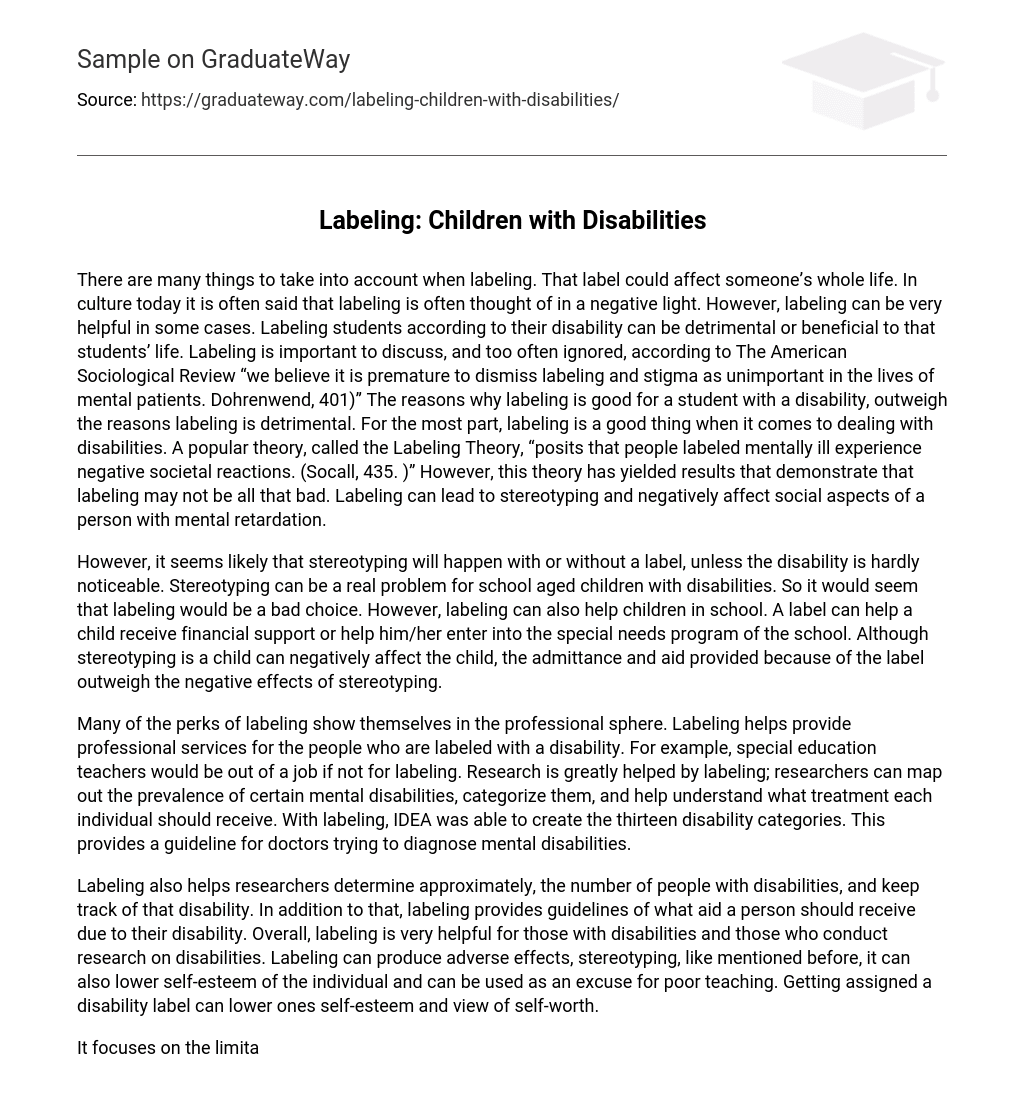There are many things to take into account when labeling. That label could affect someone’s whole life. In culture today it is often said that labeling is often thought of in a negative light. However, labeling can be very helpful in some cases. Labeling students according to their disability can be detrimental or beneficial to that students’ life. Labeling is important to discuss, and too often ignored, according to The American Sociological Review “we believe it is premature to dismiss labeling and stigma as unimportant in the lives of mental patients. Dohrenwend, 401)” The reasons why labeling is good for a student with a disability, outweigh the reasons labeling is detrimental. For the most part, labeling is a good thing when it comes to dealing with disabilities. A popular theory, called the Labeling Theory, “posits that people labeled mentally ill experience negative societal reactions. (Socall, 435. )” However, this theory has yielded results that demonstrate that labeling may not be all that bad. Labeling can lead to stereotyping and negatively affect social aspects of a person with mental retardation.
However, it seems likely that stereotyping will happen with or without a label, unless the disability is hardly noticeable. Stereotyping can be a real problem for school aged children with disabilities. So it would seem that labeling would be a bad choice. However, labeling can also help children in school. A label can help a child receive financial support or help him/her enter into the special needs program of the school. Although stereotyping is a child can negatively affect the child, the admittance and aid provided because of the label outweigh the negative effects of stereotyping.
Many of the perks of labeling show themselves in the professional sphere. Labeling helps provide professional services for the people who are labeled with a disability. For example, special education teachers would be out of a job if not for labeling. Research is greatly helped by labeling; researchers can map out the prevalence of certain mental disabilities, categorize them, and help understand what treatment each individual should receive. With labeling, IDEA was able to create the thirteen disability categories. This provides a guideline for doctors trying to diagnose mental disabilities.
Labeling also helps researchers determine approximately, the number of people with disabilities, and keep track of that disability. In addition to that, labeling provides guidelines of what aid a person should receive due to their disability. Overall, labeling is very helpful for those with disabilities and those who conduct research on disabilities. Labeling can produce adverse effects, stereotyping, like mentioned before, it can also lower self-esteem of the individual and can be used as an excuse for poor teaching. Getting assigned a disability label can lower ones self-esteem and view of self-worth.
It focuses on the limitations and not the abilities of the individual. Labeling does not always lead to low self-worth, if the individual understands that being labeled with a disability does not mean that they are any less of a person than someone without. Everyone has their own problems and issues to deal with, just not all of them are labeled. Sometimes teachers use labels as an excuse for poor teaching, they claim the child cannot learn a subject because of their mental disability, when it is their own lack of caring or trying that resulted in the child not being able to understand the concept.
One of the worse side effects of labeling is the affect it can have on an individual’s life. It can make it difficult for labeled individuals to participate in normal life activities. Person first language is also affected by labeling. Until educated about person first language, people commonly say a person who has autism, an “autistic child. ” By using language like autistic child, it is defining the child by his or her autism, when the autism is a problem that child has. Despite all of these adverse effects the benefits of labeling still outweigh the problems.
By labeling, people can receive aid, and the help they need. Labeling provides the necessary information needed to talk professionally about disabilities, and keep track of the prevalence of disabilities. It can also help people that have special needs be accommodated. Although there are some negative affects of labeling, like stereotyping, the positive effects outweigh the negative and labeling is more helpful than harmful. Works Cited Dohrenwend,Bruce P. and Link, Bruce G. Cullen, Francis T. Struening, Elmer. Shrout, Patrick E. A Modified Labeling Theory Approach to Mental Disorders: An Empirical Assessment” American Sociological Review; American Sociological Association. Vol. 54, No. 3 (Jun. , 1989), pp. 400-423. Stable URL: http://www. jstor. org/stable/2095613 Socall, W. Daniel and Thomas Holtgraves. Attitudes toward the Mentally Ill: The Effects of Label and Beliefs. Wiley on behalf of the Midwest Sociological Society, The Sociological Quarterly , Vol. 33, No. 3 (Autumn, 1992), pp. 435-445. Article Stable URL: http://www. jstor. org/stable/4121327





